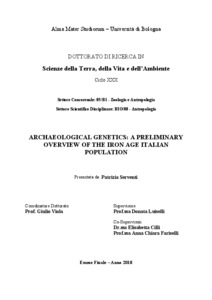Serventi, Patrizia
(2018)
Archaeological genetics: a preliminary overview of the Iron Age Italian population, [Dissertation thesis], Alma Mater Studiorum Università di Bologna.
Dottorato di ricerca in
Scienze della terra, della vita e dell'ambiente, 30 Ciclo. DOI 10.6092/unibo/amsdottorato/8577.
Documenti full-text disponibili:
![[img]](http://amsdottorato.unibo.it/8577/1.hassmallThumbnailVersion/Serventi_Patrizia_tesi.pdf)  Anteprima |
|
Documento PDF (English)
- Richiede un lettore di PDF come Xpdf o Adobe Acrobat Reader
Disponibile con Licenza: Salvo eventuali più ampie autorizzazioni dell'autore, la tesi può essere liberamente consultata e può essere effettuato il salvataggio e la stampa di una copia per fini strettamente personali di studio, di ricerca e di insegnamento, con espresso divieto di qualunque utilizzo direttamente o indirettamente commerciale. Ogni altro diritto sul materiale è riservato.
Download (45MB)
| Anteprima
|
Abstract
Recent studies suggest that Italian population shows a higher degree of internal genomic variability than other European populations. This scenario is the result of complex demographic dynamics, dating back mainly from Late Palaeolithic and Neolithic, but also dating to Metal Ages. In fact, numerous population movements occurred between the Mediterranean basin and the Middle East during the Metals Ages, a period that has determined the transformation of the first social organizations in ancient civilizations. During the 1st millennium BC, Italy appeared as a patchwork of different peoples, either whose origin remain still largely unresolved (e.g. Ligures, Veneti and, Etruscans), or that are known to have originated from specific migration processes (e.g. Celts in North-Western Italy; Greeks and Phoenician-Punic in Southern Italy, Sardinia, and Sicily). In this thesis, I focused my attention on the Italian Iron Age period, in particular on the ancient ‘Piceni’ (Case Study I) and ‘Punic’ (Case Study II) populations, and I analysed the ancient DNA (aDNA) of skeletal remains coming from the Novilara necropolis located in Central Italy (Case Study I), and from Tharros (Capo San Marco - Sardinia, IT) and Lilybaeum (Corso Gramsci - Sicily, IT) necropolises (Case Study II). I have applied different aDNA protocols and methods in order to obtain ancient mitochondrial DNA (HVS-I) (Case Study I and II) or complete genome (Case Study II). This research provides a pioneering survey on the ancient genetic diversity of Italy, contributing to disentangle the migration patterns and the relationships between ancient and presentday populations of the Mediterranean basin.
Abstract
Recent studies suggest that Italian population shows a higher degree of internal genomic variability than other European populations. This scenario is the result of complex demographic dynamics, dating back mainly from Late Palaeolithic and Neolithic, but also dating to Metal Ages. In fact, numerous population movements occurred between the Mediterranean basin and the Middle East during the Metals Ages, a period that has determined the transformation of the first social organizations in ancient civilizations. During the 1st millennium BC, Italy appeared as a patchwork of different peoples, either whose origin remain still largely unresolved (e.g. Ligures, Veneti and, Etruscans), or that are known to have originated from specific migration processes (e.g. Celts in North-Western Italy; Greeks and Phoenician-Punic in Southern Italy, Sardinia, and Sicily). In this thesis, I focused my attention on the Italian Iron Age period, in particular on the ancient ‘Piceni’ (Case Study I) and ‘Punic’ (Case Study II) populations, and I analysed the ancient DNA (aDNA) of skeletal remains coming from the Novilara necropolis located in Central Italy (Case Study I), and from Tharros (Capo San Marco - Sardinia, IT) and Lilybaeum (Corso Gramsci - Sicily, IT) necropolises (Case Study II). I have applied different aDNA protocols and methods in order to obtain ancient mitochondrial DNA (HVS-I) (Case Study I and II) or complete genome (Case Study II). This research provides a pioneering survey on the ancient genetic diversity of Italy, contributing to disentangle the migration patterns and the relationships between ancient and presentday populations of the Mediterranean basin.
Tipologia del documento
Tesi di dottorato
Autore
Serventi, Patrizia
Supervisore
Co-supervisore
Dottorato di ricerca
Ciclo
30
Coordinatore
Settore disciplinare
Settore concorsuale
Parole chiave
Mediterranean basin, Italic populations, Iron Age, Piceni, Novilara, Phoenician-Punics, Tharros, Lilybaeum, archaeogenetic, ancient DNA, mitochondrial DNA, HVS-I region, Next Generation Sequencing, kinship relationship, whole genome, population genetic.
URN:NBN
DOI
10.6092/unibo/amsdottorato/8577
Data di discussione
7 Maggio 2018
URI
Altri metadati
Tipologia del documento
Tesi di dottorato
Autore
Serventi, Patrizia
Supervisore
Co-supervisore
Dottorato di ricerca
Ciclo
30
Coordinatore
Settore disciplinare
Settore concorsuale
Parole chiave
Mediterranean basin, Italic populations, Iron Age, Piceni, Novilara, Phoenician-Punics, Tharros, Lilybaeum, archaeogenetic, ancient DNA, mitochondrial DNA, HVS-I region, Next Generation Sequencing, kinship relationship, whole genome, population genetic.
URN:NBN
DOI
10.6092/unibo/amsdottorato/8577
Data di discussione
7 Maggio 2018
URI
Statistica sui download
Gestione del documento:


 Login
Login
